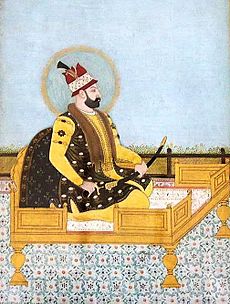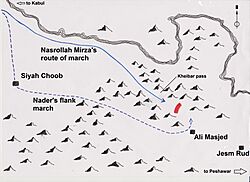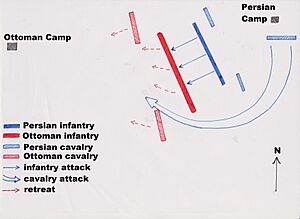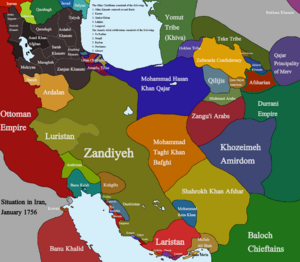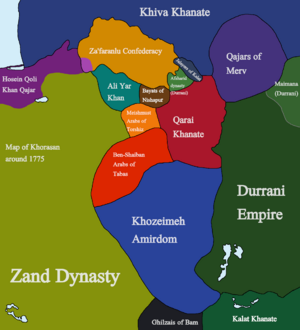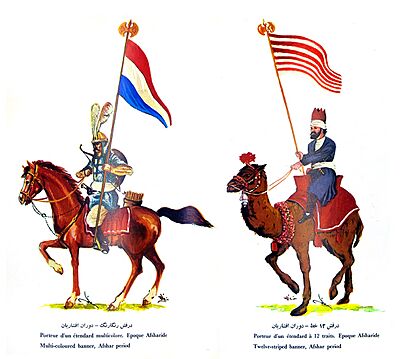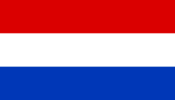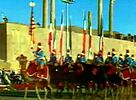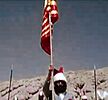Afsharid Iran facts for kids
Quick facts for kids
Guarded Domains of Iran
|
|||||||||||||||||||||
|---|---|---|---|---|---|---|---|---|---|---|---|---|---|---|---|---|---|---|---|---|---|
| 1736–1796 | |||||||||||||||||||||
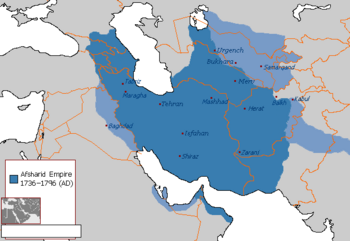
The Afsharid Empire at its greatest extent in 1741–1745 under Nader Shah
|
|||||||||||||||||||||
| Status | Empire | ||||||||||||||||||||
| Capital | Mashhad | ||||||||||||||||||||
| Common languages |
|
||||||||||||||||||||
| Religion | |||||||||||||||||||||
| Government | Absolute monarchy | ||||||||||||||||||||
| Shahanshah | |||||||||||||||||||||
|
• 1736–1747
|
Nader Shah | ||||||||||||||||||||
|
• 1747–1748
|
Adel Shah | ||||||||||||||||||||
|
• 1748
|
Ebrahim Afshar | ||||||||||||||||||||
| History | |||||||||||||||||||||
|
• Established
|
22 January 1736 | ||||||||||||||||||||
|
• Disestablished
|
1796 | ||||||||||||||||||||
| Population | |||||||||||||||||||||
|
• Estimate
|
6,000,000 | ||||||||||||||||||||
| Currency | Toman | ||||||||||||||||||||
| ISO 3166 code | IR | ||||||||||||||||||||
|
|||||||||||||||||||||
The Guarded Domains of Iran, also known as Afsharid Iran or the Afsharid Empire, was a powerful empire in Iran during the mid-1700s. It was started by the Turkoman Afshar tribe in the north-eastern part of Iran called Khorasan. The founder of this empire was Nader Shah, a very skilled military leader. He became the new ruler, or Shah, in 1736 after removing the last ruler of the Safavid dynasty.
During Nader Shah's time, the empire grew very large. It included areas that are now Iran, Armenia, Georgia, Azerbaijan, Afghanistan, Bahrain, Turkmenistan, and Uzbekistan. It also covered parts of Iraq, Pakistan, Turkey, United Arab Emirates, Oman, and the North Caucasus. After Nader Shah died, his empire broke into smaller parts. The Zands, Durranis, and Georgians took control of many areas. The Afsharid family then only ruled a small part of Khorasan. In 1796, Agha Mohammad Khan Qajar took over, ending the Afsharid rule. He started a new Iranian empire and brought many of the lost regions back under Iranian control.
The dynasty got its name from the Turkoman Afshar tribe. This tribe came from Khorasan in north-east Iran, which was Nader Shah's home region. The Afshars had moved from Turkestan to Azerbaijan in the 1200s. Later, in the early 1600s, Abbas the Great moved many Afshars to Khorasan. This was to help protect the north-eastern borders of his state from the Uzbeks. Nader Shah belonged to a specific part of the Afshar tribe called the Qereqlu branch.
History of the Afsharid Empire
How the Dynasty Began
Nader Shah, originally named Nadr Qoli, came from a humble family in Khorasan. He started as a local leader. His rise to power began when the Ghilzai Mir Mahmud Hotaki took over the weakened Safavid empire in 1722. At the same time, the Ottoman and Russian forces took Iranian land. Russia gained parts of Iran's Caucasian territories in the Russo-Persian War. The Ottomans invaded from the west. In 1724, they agreed to divide the conquered areas.
Nader joined forces with Sultan Husayn's son, Tahmasp II. He led the fight against the Ghilzai Afghans. In 1729, he easily drove their leader Ashraf Khan out of the capital. Tahmasp became the new ruler. Nader then worked to get back the lands lost to the Ottomans and Russians. He also wanted to restore Iran's power. While Nader was fighting in the east, Tahmasp made a bad decision. He tried to regain land in the Caucasus, but lost more territory to the Ottomans. Nader was unhappy and removed Tahmasp from power in 1732. He put Tahmasp's young son, Abbas III, on the throne instead. Four years later, Nader had taken back most of the lost Persian lands. He then felt strong enough to declare himself Shah at a ceremony on the Moghan Plain.
Nader then made the Russians give back the territories they took in 1722–23. This happened through the Treaty of Resht in 1732 and the Treaty of Ganja in 1735. With northern Iran back under control, Nader continued the war against the Ottomans. He pushed the Ottoman armies out of western Iran and the rest of the Caucasus. The 1736 Treaty of Constantinople made the Ottomans confirm Iran's control over the Caucasus. It also recognized Nader as the new Shah.
Nader Shah's Conquests
Defeating the Hotaki Dynasty
Tahmasp and the Qajar leader Fath Ali Khan asked Nader to help them. They wanted to drive the Ghilzai Afghans out of Khorasan. Nader agreed and became an important national figure. Nader found out that Fath Ali Khan was working with another leader. He told the Shah, who then executed Fath Ali Khan. Nader became the chief of the army. He took the title Tahmasp Qoli, meaning "Servant of Tahmasp." In late 1726, Nader recaptured Mashhad.
Nader decided not to go straight to Isfahan. First, in May 1729, he defeated the Abdali Afghans near Herat. Many of these Afghans then joined his army. The new Ghilzai Afghan ruler, Ashraf, decided to fight Nader. But Nader defeated him in September 1729 at the Battle of Damghan. He won again in November at Murchakhort, driving the Afghans out of Persia for good. Ashraf ran away, and Nader entered Isfahan. He gave the city to Tahmasp in December and collected treasures to pay his army. Tahmasp made Nader governor of many eastern provinces, including Khorasan. He also married Nader to his sister. Nader chased and defeated Ashraf, who was later killed by his own followers. In 1738, Nader Shah attacked and destroyed the last Hotaki stronghold at Kandahar. He built a new city nearby and named it "Naderabad."
Regaining Lost Territories
In 1735, Nader attacked the Ottomans and regained most of the land lost during the recent troubles. At the same time, the Abdali Afghans rebelled and attacked Mashhad. This forced Nader to stop his campaign and save his brother, Ebrahim. It took Nader fourteen months to stop this uprising.
Nader and the Shah's relationship worsened. The Shah was worried about Nader's military success. While Nader was away, Tahmasp tried to recapture Yerevan. But he lost all of Nader's recent gains to the Ottomans. He then signed a treaty giving up Georgia and Armenia for Tabriz. Nader was very angry. He saw this as a chance to remove Tahmasp from power. He spoke out against the treaty, gaining public support for a war against the Ottomans. In 1732, Nader forced Tahmasp to step down. He made the Shah's baby son, Abbas III, the new ruler, with Nader as his guardian.
Nader continued the war from 1730–35. He planned to take Ottoman Baghdad and trade it for the lost provinces. But his plan failed when his army was defeated by the Ottoman general Topal Osman Pasha near Baghdad in 1733. Nader needed to act fast to keep his power, as revolts were starting in Persia. He faced Topal again with a larger army, defeating and killing him. He then attacked Baghdad and Ganja in the northern provinces. This led to an alliance with Russia against the Ottomans. Nader won a big victory over a larger Ottoman force at Yeghevard (in modern-day Armenia). By the summer of 1735, Persian Armenia and Georgia were back under his control. In March 1735, he signed a treaty with the Russians in Ganja. The Russians agreed to remove all their troops from Persian land. This brought all of the Caucasus and northern mainland Iran back under Iranian rule.
Nader Becomes King
After a hunting trip on the Moghan plains, Nader suggested to his close friends that he should become the new king instead of young Abbas III. His friends agreed. Nader then decided to gather all the important leaders of the state. He wanted them to agree to him becoming king in a written document. Nader approved this idea. Orders were sent out to military, religious, and noble leaders to meet on the plains. People started arriving in January 1736. In that same month, Nader held a qoroltai (a large meeting like those of Genghis Khan and Timur) on the Moghan plains. Everyone agreed that Nader should be the new king. Many were excited, while others feared Nader's anger if they supported the old Safavid rulers. Nader was crowned Shah of Iran on March 8, 1736. This date was chosen by his astrologers as a very lucky day. A very large group of military, religious, and noble leaders, along with the Ottoman ambassador, attended the ceremony.
Invading the Mughal Empire

In 1738, Nader Shah conquered Kandahar, the last stronghold of the Hotaki dynasty. He then turned his attention to the Mughal Empire in Delhi. This once powerful state was weakening, with nobles disobeying and the Hindu Maratha Empire taking land. Its ruler, Muhammad Shah, could not stop this. Nader asked for Afghan rebels who had taken refuge in India to be handed over, but the Mughal emperor refused.
Nader used the excuse of the Afghan rebels to invade the rich but militarily weak Mughal Empire. He led a small group of his forces through difficult mountain passes. He surprised the enemy forces at the Khyber Pass, defeating them even though they outnumbered him. This led to the capture of Ghazni, Kabul, Peshawar, Sindh, and Lahore.
As Nader entered Mughal lands, his loyal Georgian subject, Erekle II, joined him. Erekle II, who would later become king of eastern Georgia, led a Georgian group in Nader's army. After defeating Mughal forces, Nader moved deeper into India. News of the Persian army's quick victories worried Delhi. The Mughal ruler, Muhammad Shah, gathered a huge army of about 300,000 men. He marched north to meet the Persian army.

Nader Shah crushed the Mughal army in less than three hours at the large Battle of Karnal on February 13, 1739. After this big victory, Nader captured Mohammad Shah and entered Delhi with him. When a rumor spread that Nader had been killed, some Indians attacked Persian troops. Nader was very angry. He ordered his soldiers to take treasures from the city. Mohammad Shah had to beg Nader for mercy.
Nader Shah agreed to leave, but Mohammad Shah had to give up his royal treasury. He also lost the famous Peacock Throne to the Persian emperor. The Peacock Throne became a symbol of Persian power. It is thought that Nader took treasures worth a huge amount of money. Among many other jewels, Nader also gained the Koh-i-Noor and Darya-ye Noor diamonds.
The Persian troops left Delhi in early May 1739. Before leaving, Nader gave back all the territories east of the Indus River to Muhammad Shah. Nader's soldiers also took thousands of elephants, horses, and camels loaded with the treasures they had collected. On his way back, Sikhs attacked Nader Shah's troops, taking some of the loot. However, the remaining treasures from India were so valuable that Nader stopped taxation in Iran for three years after his return. Nader attacked the empire to give his country a break after past troubles. His successful campaign and new funds meant he could continue his wars against Iran's rival, the Ottoman Empire.
Later Campaigns and Challenges

The Indian campaign was the peak of Nader's career. After returning from India, Nader had problems with his oldest son, Reza Qoli Mirza. Reza had ruled Persia while his father was away. He had acted harshly. Hearing a rumor that Nader was dead, he had the Safavid royal captives killed. Nader was not happy with his son's actions and removed him from his position. However, he took him on an expedition to conquer land in Transoxiana. Nader became more and more strict as his health got worse. In 1740, he conquered the Khanate of Khiva. After the Persians made the Uzbek khanate of Bukhara surrender, Nader wanted Reza to marry the khan's older daughter. She was a descendant of Genghis Khan, whom Nader admired. But Reza refused, so Nader married the girl himself. Nader also conquered Khwarezm on this trip into Central Asia.
Nader then decided to punish Daghestan for the death of his brother Ebrahim Qoli. In 1741, an assassin tried to shoot Nader while he was traveling. Nader was only slightly hurt. He began to suspect his son was involved and kept him in Tehran. Nader's worsening health made his temper worse. He struggled in his war against the Lezgin tribes of Daghestan. They used guerrilla warfare, making it hard for the Persians to win. Nader took most of Dagestan, but the effective guerrilla tactics by the Lezgins, Avars, Laks, and Dargins meant Iranian control was short-lived. Nader was forced to leave several years later. During this time, Nader accused his son of the assassination attempt. Reza strongly said he was innocent, but Nader had him blinded as punishment. He regretted it immediately. Soon after, Nader started executing nobles who had seen his son's blinding. In his last years, Nader became very suspicious, ordering the killing of many suspected enemies.
With the wealth he gained, Nader began to build a Persian navy. He used wood from Mazandaran and Gilan to build ships in Bushehr. He also ordered new cannons to be built in Amol. He bought thirty ships in India. He recaptured the island of Bahrain from the Arabs. In 1743, he conquered Oman and its capital, Muscat. In 1743, Nader started another war against the Ottoman Empire. Even with a huge army, Nader did not show his usual military skill in this campaign. It ended in 1746 with a peace treaty. The Ottomans agreed to let Nader control Najaf.
Military Power
The Afsharid dynasty's military started as a small group of fighters. They were led by Nader Qoli during a time of chaos in Iran. At first, Nader had only a few hundred men. But at the peak of his power, as the king of kings, he commanded an army of 375,000 soldiers. This was the strongest military force of its time. It was led by one of history's most skilled military leaders.
After Nader Shah was killed by some of his officers in 1747, his powerful army broke apart. The Afsharid state fell into decades of civil war. Many Afsharid rulers tried to take control of the whole country. But Persia remained divided until Agha Mohammad Khan Qajar reunified the nation in the late 1700s.
Civil War and the End of the Afsharids
After Nader's death in 1747, his nephew Ali Qoli took the throne. He called himself Adel Shah ("The Just King"). He ordered the killing of all Nader's sons and grandsons, except for 13-year-old Shahrokh. Meanwhile, Nader's former treasurer, Ahmad Shah Abdali, declared his independence. He founded the Durrani Empire. Because of this, the eastern territories were lost and became part of Afghanistan. The northern territories of Iran had a different fate. Erekle II and Teimuraz II had been made kings of Kakheti and Kartli by Nader himself. They used the instability to declare themselves independent. Erekle II took control of Kartli after Teimuraz II died. This united the two as the Kingdom of Kartli-Kakheti. He became the first Georgian ruler in three centuries to lead a united eastern Georgia. He remained independent during the Zand period. Later, under the Qajar dynasty, Iran tried to regain control over the Georgian regions. But they were eventually lost to Imperial Russia in the 1800s. Many other areas in the Caucasus, including modern-day Azerbaijan, Armenia, and Dagestan, became separate khanates. These rulers had some independence but remained loyal to the Iranian king. Under the early Qajars, these territories were brought back into Iran. But they were also permanently lost to Imperial Russia in the 1800s.
Adil made a mistake by sending his brother Ebrahim to secure the capital, Isfahan. Ebrahim decided to become a rival. He defeated Adil in battle, blinded him, and took the throne. Adil had ruled for less than a year. Meanwhile, army officers freed Shahrokh from prison in Mashhad. They declared him shah in October 1748. Ebrahim was defeated and died in prison in 1750. Adil was also killed at the request of Nader Shah's widow. Shahrokh was briefly removed from power for another ruler, Soleyman II. But even though he was blinded, Shahrokh was put back on the throne by his supporters. He ruled in Mashhad, but from the 1750s, his territory was mostly just the city and its surrounding areas. He also faced invasions from the Durranis. He eventually became controlled by Ahmad Shah in the second campaign. In 1796, Mohammad Khan Qajar, who started the Qajar dynasty, took Mashhad. He tortured Shahrokh to make him reveal where Nader Shah's treasures were hidden. Shahrokh died soon after, and with him, the Afsharid dynasty ended. One of Shahrokh's sons, Nader Mirza, rebelled in 1797 after Agha Mohammad Khan Qajar died. But the rebellion was stopped, and he was executed in April 1803. Shahrokh's family continues to live today under the Afshar Naderi surname.
Religious Policies
The Safavids had made Shi'a Islam the official religion of Iran. Nader grew up as a Shi'a Muslim. But later, he wanted to unite with the Sunni faith as he gained power. He believed that the Safavid Shi'ism made conflicts with the Sunni Ottoman Empire worse. His army had both Shi'a and Sunni Muslims, plus a few Christians. It included his own Qizilbash soldiers, as well as Uzbeks, Afghans, Christian Georgians and Armenians, and others. He wanted Persia to adopt a form of Shi'a Islam that Sunnis would find more acceptable. He suggested a form of Shi'ism called "Ja'fari," named after the sixth Shi'a Imam Ja'far al-Sadiq. He banned some Shi'a practices that offended Sunnis, like cursing the first three caliphs. Nader himself was said to not care much about religion. A French Jesuit who was his personal doctor said it was hard to know what religion Nader followed. Many who knew him best said he had no religion. Nader hoped that "Ja'farism" would be accepted as a fifth school of Sunni Islam. He also hoped the Ottomans would allow its followers to go on the hajj, or pilgrimage, to Mecca, which was in their territory. In later peace talks, the Ottomans did not accept Ja'farism as a fifth school. But they did allow Persian pilgrims to go on the hajj. Nader was interested in getting rights for Persians to go on the hajj partly because of the money from pilgrimage trade. Nader's other main goal in his religious changes was to weaken the Safavids. This was because radical Shi'a Islam had always been a big support for the Safavid dynasty. He had the chief mullah of Persia killed after he supported the Safavids. One of Nader's changes was the kolah-e Naderi, a hat with four peaks. These peaks symbolized the first four caliphs.
Flags of the Empire
Nader Shah purposely avoided using the color green. This was because green was linked to Shia Islam and the Safavid dynasty.
The two main imperial flags were placed on the right side of the square. One flag had stripes of red, blue, and white. The other had stripes of red, blue, white, and yellow, with no other designs. The old flags needed 12 men to carry them. The Shah made their poles longer and heavier. He also put new silk colors on them. One was red and yellow striped, and the other was yellow with red edges. They were made very large so that the enemy could not easily take them unless they won a complete victory. The flags for the army regiments were narrow silk strips, pointed at the end. Some were red, some white, and some striped.
The Navy Admiral's flag was white with a red Persian Sword in the middle. Based on the writings of Jonas Hanway, we know that the army flags of King Nader had three points. However, we cannot be sure if the royal flags of that time had three or four points.
Gallery
-
Afsharians parade in Persepolis
See also
 In Spanish: Dinastía afsárida para niños
In Spanish: Dinastía afsárida para niños




